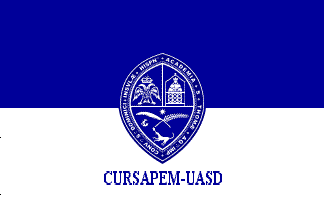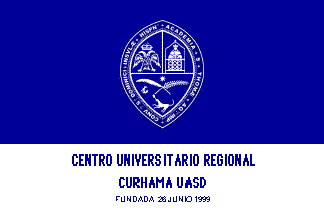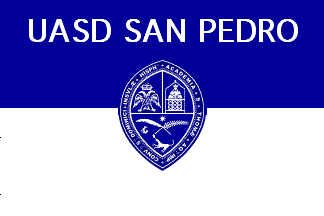
This page is part of © FOTW Flags Of The World website
Universidad Autónoma de Santo Domingo (Dominican Republic)
Autonomous University of Santo Domingo
Last modified: 2015-05-09 by randy young
Keywords: dominican republic | autonomous university of santo domingo | universidad autónoma de santo domingo | bicolor: horizontal (blue-white) |
Links: FOTW homepage |
search |
disclaimer and copyright |
write us |
mirrors

image by Ivan Sache, 5 December 2014
See also:
Universidad Autónoma de Santo Domingo (UASD) is a State, decentralized public institution, organized in the Faculties of Humanities, Sciences, Economical and Social Sciences, Law and Political Sciences, Engineering and Architecture, Health Sciences, Agronomic and Veterinary Sciences, Art, and Education Sciences. The Faculties are organized in Institutes, Schools and Chairs. Headquartered in Santo Domingo, UASD has seats (recintos universitariios) in the towns of Puerto Plata, Higüey, Barahona, San Francisco de Macorís, Mao, Santiago Rodríguez, Santiago, Bonao, San Juan de la Maguana, Nagua, Hato Mayor, La Vega, Bani, San Pedro de Macorís, Samana, San Cristobal, La Romana, and Neyba.
UASD proudly uses the motto Primada de América (The First in America); the university claims to be the continuation of the first university ever established in the Americas. The Order of Preachers (Dominican Order) founded in 1518 an Estudio General (General College) in Santo Domingo, formed by the Faculties of Medicine, Law, Theology, and Art. Art teaching was divided into "trivium" - Grammar, Rhetoric, Logic - and "quadrivium" - Arithmetic, Geometry, Astronomy, and Music. This structure was inherited from the medieval period, but the content and methods of teaching were dramatically revamped, on the model of the University of Alcalá de Henares, the original Complutense University (Spain).
The Prior and the friars of the Dominican convent of Santo Domingo required from the Pope the same statutes and privileges already granted to the other Spanish universities. Universidad de Santo Tomás de Aquino (also known as Pontificia Universidad de Santo Domingo) was eventually established by the Bull In Apostolatus Culmine, signed on 28 October 1538 by Pope Paul III (papacy, 1534-1549). The university was declared Real (Royal) by Royal Letters signed on 27 July 1734 by King of Spain Philip V (reign, 1700-1746).
In the 19th-20th centuries, the university had its ups and downs, reflecting the ups and downs of the country. In 1801, the Dominicans left the country after the invasion by the revolted slaves led by Toussaint-Louverture (c. 1743-1803). The university remained closed until 1815, when it was re-activated by the re-established Spanish colonial authorities and placed under secular regime. The university was closed once again in 1822 following the forced unification of the whole Hispaniola island by the Haitians and the suppression of the short-lived Independent State of Spanish Haiti (December 1821-February 1822, a period known as the "Short-lived Independence").
The independence of the Dominican Republic was eventually proclaimed in 1844. Pedro Santana (1800-1864), 1st (1844-1848), 4th (1853-1856) and 8th (1858-1861) President of the Republic, signed on 16 June 1859 the law establishing Universidad de Santo Domingo as a State university. The medieval structure was maintained, with the four Faculties of Philosophy, Jurisprudence, Medical Sciences, and Sacred Literature. The return to the Spanish colonial rule obtained by Santana in 1861 and the outbreak of the War of Restoration in 1863 prevented the actual re-establishment of the university. After the evacuation of the country by the Spanish authorities in 1866 and the restoration of national sovereignty, the Decree of 31 December 1866 established the Instituto Profesional. Closed on 10 May 1891 and reactivated on 16 August 1895, the institute worked as a surrogate university.
Universidad de Santo Domingo was eventually re-established by a Decree signed on 16 November 1914 by Dr. Ramón Báez (1858-1929), Rector of the Instituto Profesional and Provisory President of the Republic (28 August - 5 December 1914). The university was soon closed after the US intervention and remained so during the occupation of the country (1916-1924).
During the tyrannical rule exerted from 1930 to 1961 by Generalissimo Rafael Trujillo (1891-1961), the university, like all the other institutions of the country, was under total political control and mostly used as a means of propaganda of the totalitarian rule. Universidad Autónoma de Santo Domingo was established by Law No. 5,778 of 31 December 1961. The first autonomous authorities of UASD were elected on 17 February 1962.
Ivan Sache, 5 December 2014, from University website's History section
See also:
The elements of the institutional image of UASD are prescribed in Chapter 18 (Articles 118-127) of the university's Statutes, last revised on 8 February 2012 and published in April 2012, as "a set of emblems and symbols that convey the university's essence for which it is recognized at the national and world level, and that are part of its cultural heritage" (Article 118). The university's original Statues can be found here.
Ivan Sache, 5 December 2014
The flag is described in Article 121:
"The flag shall be made of a rectangle displayed horizontally, of the same dimensions as the national flag, divided into two equal horizontal stripes. The upper stripe shall be indigo blue (Reflex blue) while the lower stripe shall be white. In the middle of the flag and kept in the same dimensions in the upper, lower and lateral parts, shall be placed the emblem; the upper part of the oval shall be bordered with a white line for the sake of differentiation from the blue background in that part of the flag.
All the university's buildings shall hoist the university flag together with the national flag and other flags prescribed by the protocol, in front of the buildings and during official events."
Ivan Sache, 5 December 2014
The colours are described in Article 120:
"The official academic colours shall be indigo blue (Reflex blue) and white. Blue means stability, liberty, dignity and science, which match the academic concepts and principles. White is the colour of beginning, birth, purity and truth, as the cradle of knowledge and the beacon light in scientific truth symbolized by the university. Indigo blue (Reflex blue) and white shall be the sole institutional identity. Tonalities and variants shall not be used, except in cases specified in the regulations that prescribe the use of the elements of the institutional identity."
Ivan Sache, 5 December 2014
The emblem is described in Article 119:
"The emblem of Universidad Autónoma de Santo Domingo shall be made of an oval divided into three parts;
- the upper left part features the imperial, double-headed eagle of the Habsburg family.
- in the upper right part is placed the Chair of St. Thomas Aquinas*, disciple of St. Dominic de Guzman, the founder of the Dominican Order.
- in the lower and median parts of the oval is shown a dog carrying a torch in its mouth and setting the earth on fire, as a symbol of the oratorical skills of the Order of Preachers**.
- above is a star symbolizing the mark St. Dominic had on his forehead***, and two crossed branches of laurel and palm, which represent the triumph of the Order of Preachers.
This emblem shall be used in all the decentralized seats of the university (recintos, centers and subcenters), in all the Faculties and in all their dependencies. No other emblem shall be used for official purpose, either redesigned or distorted.
*The Chair of St. Thomas is described in Article 125:
"The University Chair is a symbol representing the Chair of Philosophy of St. Thomas Aquinus, which shall be used by the Rector during solemn events celebrated in the Aula Magna [the main auditorium, built in 1957 and described in detail in Article 126]. It is a treasure from the colonial period, sculpted in the 16th century in mahogany wood. The bases of this historical piece of furniture feature the four Evangelists as follows [...]"
**The Legend (first biography of St. Dominic) narrates a vision that his mother, Blessed Joan de Aza, had before he was born. When she was pregnant with him, she had a dream, in which she saw a puppy coming out of her womb with a burning torch in its mouth. Unable to make sense of her dream she decided to seek the intercession of Santo Domingo de Silos, the founder of the famous Benedictine monastery nearby. She made a pilgrimage to Silos to ask the saint to unfold her dream for her. There she was made to understand that, through preaching, her son would set the world on fire for Christ. In recognition, she named her son Domingo, in Latin Dominicus, which means "Of the Lord". From Dominicus comes Dominicanus (Dominican, that is pertaining to the Order of St Dominic). However, here the often repeated but ungrammatical played on words by saying that Dominicanus is a combination of Dominus (Lord) and canis (dog), therefore coming to signify "the Lord’s dog," or watchman over the Lord’s vineyard.
*** We are told in the same Legend that at Dominic’s baptism a star appeared over his forehead.
Quotes from St. Dominic Catholic Church, Panama City, Florida, USA.
The emblem appears to be similar to the greater seal granted in 1734 and described in Article 8 of the first Statutes of the university:
"The greater seal features an image of Our Doctor of the Church, St. Thomas, sitting on a chair that we have here, with a crowned eagle, which are the arms of this convent, and a star between a palm and a branch of olive crossed per saltire and a dog with a torch in its mouth setting the world on fire, which is part of the arms of the Order of Preachers. The border of the shield is inscribed with 'ACADEMIA + S [ANCTI] + THOMÆ + AQ[UINA]TIS + IMP[ERIALIS] + CONV[ENTUS] + S[ANCTI] + DOMINICI + INSULÆ + HISP[A]N[IOLÆ]' (University of St. Thomas Aquinus of the Imperial Convent of Santo Domingo in Hispaniola Island)."
Ivan Sache, 5 December 2014
UASD organizes every year the Tony Barreiro Games, named for Jesús
Antonio Barreiro (1935-1963), a student at UASD fond of sports. A
member of the Movimiento Revolucionario 14 de Junio, Barreiro was arrested on 8 September 1959, tortured and sentenced to 30 years of imprisonment in a working camp. Released after Trujillo's death, he carried on the armed struggle against Juan Bosch's constitutional government and was killed on 23 December 1963.
Ivan Sache, 5 December 2014

image by Ivan Sache, 5 December 2014
A flag shown by students during the Games 2011 is inscribed in the white stripe with "CURSAPEM-UASD", in blue letters. The acronym stands for "Centro Universitario San Pedro de Macorís."
Ivan Sache, 5 December 2014

image by Ivan Sache, 5 December 2014
A flag used during the Games 2012 has the UASD emblem placed in the blue stripe, which is twice higher than the white one. The white stripe is inscribed with "CENTRO UNIVERSITARIO REGIONAL / CURHAMA UASD / FUNDADA 26 JUNIO 1999" in blue letters of decreasing size. The acronym stands for "Centro Universitario Hato Mayor."
Ivan Sache, 5 December 2014

image by Ivan Sache, 5 December 2014
A flag used during the Games 2014 is inscribed in the blue stripe with "UASD SAN PEDRO" in white letters.
Ivan Sache, 5 December 2014




